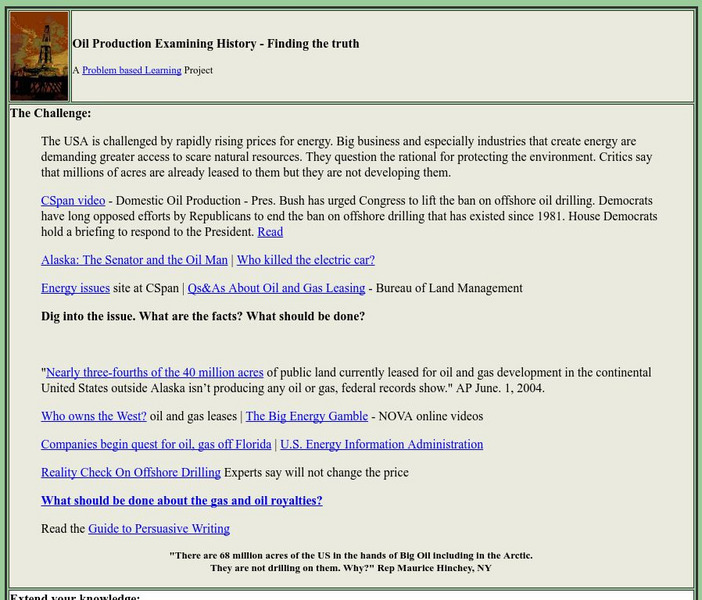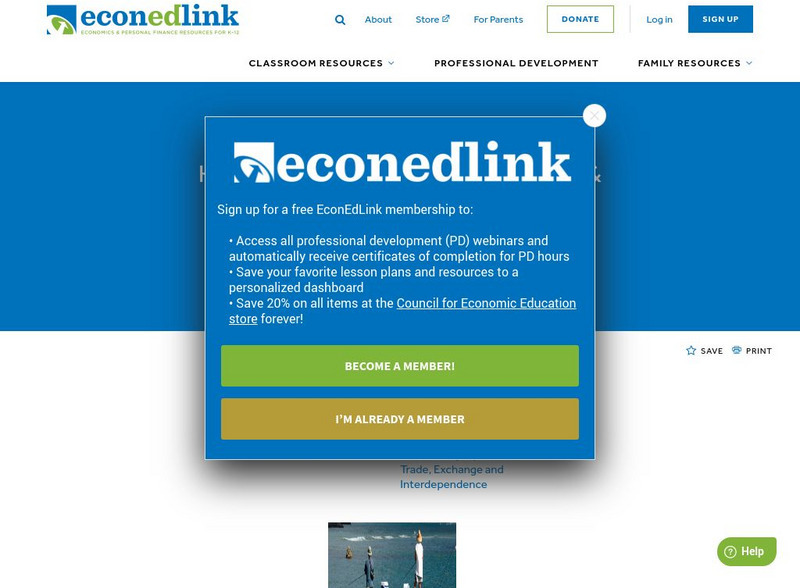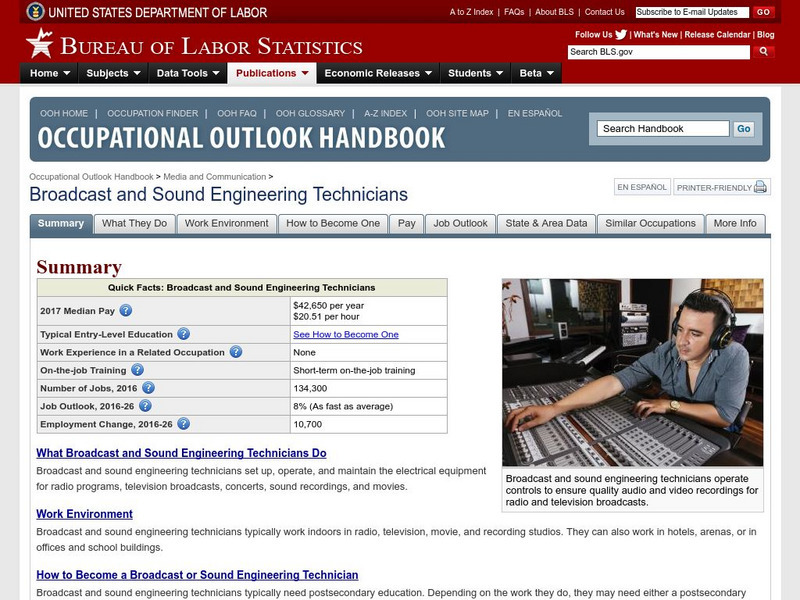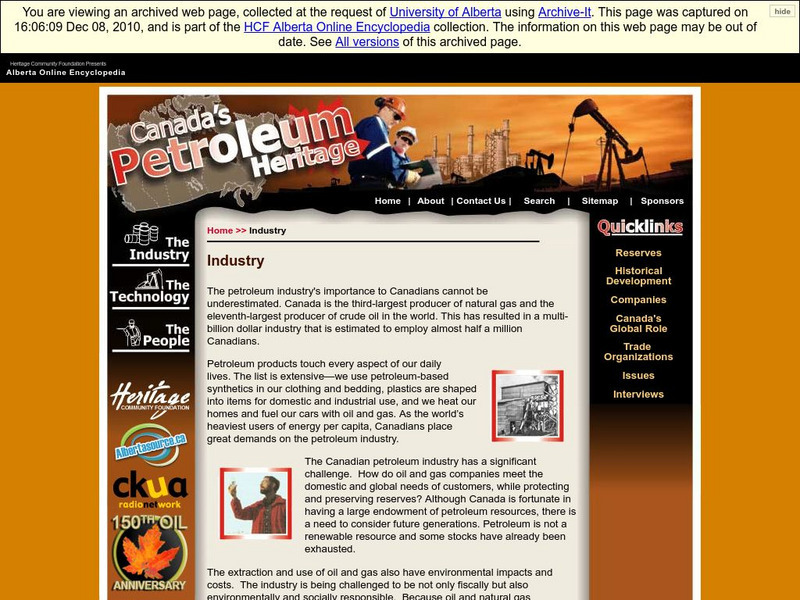Hi, what do you want to do?
Science Buddies
Science Buddies: Get Down and Dirty: How Does Soil Change With Depth?
What covers less than 10% of the Earth's surface, yet is a vital natural resource for terrestrial life? What filters ground water and supports most of our food production, not to mention the production of building materials and paper?...
ClassFlow
Class Flow: Virginia's Products and Industries
[Free Registration/Login Required] This flipchart explores the products and industries of Virginia's five geographic regions.
Polk Brothers Foundation Center for Urban Education at DePaul University
De Paul University: Center for Urban Education: Natural Gas: An Energy Resource [Pdf]
"Natural Gas: An Energy Resource" is a one page, nonfiction, reading passage about natural gas, its uses, and how it gets to homes. It is followed by constructed-response questions which require students to provide evidence from the...
Other
Amos Web: Pumping Up the Economic Growth
What is economic growth? This site not only gives a definition, but also provides a great overview of various characteristics of how economies can grow. Discusses different types of resources, possible negative effects of growth, and...
Cynthia J. O'Hora
Mrs. O's House: Oil Production Examining History Finding the Truth
Students will dig into researching the history of oil production to possibly uncover some truths about why the United States doesn't do more drilling on its own land. When research is complete, students will write persuasive letters to...
Council for Economic Education
Econ Ed Link: Hawaiian Economics: Barter for Fish & Poi
In ancient Hawaii, chiefs managed the economy by creating a land division system, the Ahupua'a, which divided the islands into pie slice shapes. Each Ahupua'a covered the three main regions of the islands: the mountains, the valleys, and...
Council for Economic Education
Econ Ed Link: The Write Stuff
Right now you are probably using a pencil to do your school work. But do you know where the pencil came from, or how it is made? Did you know that the Star Spangled Banner, written by Francis Scott Key was first written in pencil? And...
Council for Economic Education
Econ Ed Link: Where's the Beef?
Students explore meat consumption statistics, an indicator of a nation's relative prosperity and standard of living. They do a survey of a family's meat consumption and compare their results to statistics from Colonial and modern- day...
US Department of Labor
Bureau of Labor Statistics: Broadcast and Sound Engineers
This resource provides information about careers for broadcast and sound technicians. Includes information about the nature of the work, working conditions, employment, training, job outlook, earnings, and related occupations.
TeachEngineering
Teach Engineering: Biodomes
Students explore the biosphere's environments and ecosystems, learning along the way about the plants, animals, resources and natural cycles of our planet. Over the course of lessons 2-6, students use their growing understanding of...
Alberta Online Encyclopedia
Alberta Online Encyclopedia: Canada's Petroleum Heritage
Petroleum! Where does it come from? Follow its importance, technology, rank in the world, products, and more.. in this colorful, informative web site.
National Academies of Sciences, Engineering, and Medicine
The National Academies: Our Energy Sources: Natural Gas
Energy production from natural gas is less destructive to the environment than energy produced from coal, but it is still produced from fossil fuels. While advances have been made in reducing its detrimental effects, our resources are...
State Library of North Carolina
N Cpedia: Coal
Coal in North Carolina is limited to two belts of Triassic sediment: the sporadic Dan River belt and the larger Deep River belt, which runs along the Deep River in Lee, Moore, and Chatham Counties. Read on to learn about the uses and...
Georgia State University
Georgia State University: Eco Connections: Conservation of Resources
During our exploration of each previous lesson, we have learned about many of the factors that contribute to the ongoing destruction of our environment. In our final lesson, we will make a holistic appraisal of the impact that each of...
New Zealand Ministry of Education
Cork Quality Council: Harvesting Natural Cork
Learn how cork, "An eminently renewable resource harvested from the living bark of the Cork Oak," is grown, removed, and used for wine bottle corks and more. Information on the cork forest, the world's largest cork tree, and quality...
TeachEngineering
Teach Engineering: Design a Recycling Game!
Students will design a game where players try to come up with alternative uses for used products. Students will brainstorm ideas for an effective board game format.
Texas State Historical Association
Texas State Historical Association: Minerals in Texas [Pdf]
An activity guide where students refer to the Texas Almanac, which is free to download, for information needed to complete assigned tasks. In this lesson, they examine the history of oil and oil and gas production In Texas. They also...
US Department of Energy
Doe: Fossil Energy: Education Start Page
Overview of the fossil energy industry (oil, gas, coal) with detailed descriptions of the processes and the work of the people employed in the industry.
PBS
Pbs Learning Media: Global Oneness Project: Rethinking the Fabrics We Wear
In this lesson, students examine natural and synthetic fibers. Students explore the photo essay in groups and discuss how the sheep farmer offers an alternative to mass production with a focus on the themes of resiliency and...
Federal Reserve Bank
Federal Reserve Bank of St. Louis: Tortilla Factory [Pdf]
This lesson accompanies a story by Gary Paulsen called Tortilla Factory, and teaches students to identify the different types of resources (human, capital, natural, etc.) that go into creating corn tortillas and other products.
US Geological Survey
Usgs: Materials Flow and Sustainability [Pdf]
This site is a fact sheet that uses illustrations to review the steps minerals go through to be made into useable products, and also how some materials can be recycled and returned to the environment.
University of Groningen
American History: Outlines: Basic Ingredients of the Us Economy
Every economic system tries to anticipate and then meet human needs through the production and distribution of goods and services. The economic system is the mechanism that brings together natural resources, the labor supply, technology,...
Council for Economic Education
Econ Ed Link: The Economics of the Family Farm
Learn about the status of farming as a career, investigate the management of a family farm, and examine one recent farm crisis in this lesson.
Other
Successful Farming: Agriculture Online
From Successful Farming magazine, this site presents agriculture news and features for people who are professionals and those studying agriculture. Links to valuable, up-to-date information on topics such as crop news and weather patterns.







![De Paul University: Center for Urban Education: Natural Gas: An Energy Resource [Pdf] Unit Plan De Paul University: Center for Urban Education: Natural Gas: An Energy Resource [Pdf] Unit Plan](https://static.lp.lexp.cloud/images/attachment_defaults/resource/large/FPO-knovation.png)











